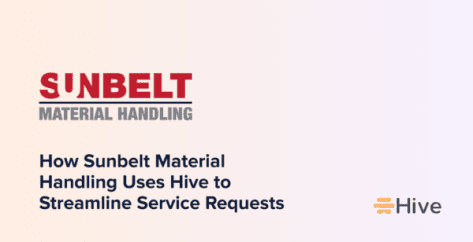Sunbelt Material Handling (SMH) provides companies with heavy-duty material handling equipment, such as forklifts and electric pallet jacks. Founded in 1987, it has five bases serving North and Central Texas and the whole of Oklahoma, providing sales and service. The company adopted Hive in the spring of 2023 to help process customer requests more effectively. Now, multiple teams at SMH use Hive, including administration, accounting, parts, service, rental and transportation.
Salesforce integration plays a key role in how SMH uses Hive, as the company’s sales reps – who are not Hive users – rely on Salesforce to process customer requests and update the status of customer requests.
We caught up with Christina Wallace, Corporate Information and Product Development at SMH, to learn how the company uses Hive and its future plans.
Before Hive: Overreliance on Email Proved Inefficient
SMH uses a process called Service Quote Request (SQR), which is set up in Salesforce as an Opportunity Record Type. An SQR could be, for example, a request for forklift repairs. SMH can then create a quote based on the parts needed, labor, and transportation costs. The sales rep presents the quote to the customer, and if they approve the quote, the request goes through the approval, ordering and repair process.
Before Hive, sales teams at SMH used a sequence of emails to manage customer requests, quotes, approvals, and orders. Working in this way involved a high amount of repetitive work. For example, when using the legacy process, sales teams had to enter customer requests into an email template, then send a separate email to the SMH accounting team to get accounts set up. After a customer approved the sales rep’s quote, the sales rep would then need to start an email exchange with the parts & service team to let them know what needed to be done.
Now, the entire process is streamlined with Hive. Let’s take a closer look at which Hive functions SMH is using to manage its day-to-day processes more efficiently.
Linking Hive and Salesforce via Hive Automate
SMH takes full advantage of Hive Automate, a powerful new feature that enables Hive users to control their team’s specific integrations and automation needs. Hive users can set up business workflows with apps like Salesforce via Hives Actions and Triggers functions. These business workflow formats can be saved into what we call ‘Recipes’. Recipes are highly customizable and can be applied to future work with just a click of a button.
Hive’s Lead Solutions Engineer Brian Holthouse helped SMH to create the right Recipe for their needs.
Customers will contact their SMH sales representative or nearest dealership with their issue. The SMH sales representative may visit the customer to take photos and get more information, if required, and will create an SQR Opportunity in Salesforce, which mirrors the email template they used before Hive.
Hive listens for the Opportunity Record Type, and when sales representatives saves the opportunity in the “SQR” status, Hive creates an action card in the SQR project. Every time that action card is moved to a new phase in Hive, it automatically updates in Salesforce as well.
Christina explains, “We have more workflow recipes set up for every time that action card is moved to a new status because we have cards from ‘submitted’ to ‘service review’, ‘shop review’, ‘parts review’, ‘parts quoted’, ‘service quoted’, and other ones all the way to ‘completed’.”
Comments are also pushed into Salesforce so sales reps can understand the context around job statuses, for example, if there is a delay due to a shortage of parts. Using Comments cuts the amount of follow-up and conversations required between sales reps and the internal team at Sunbelt Material Handling.
The company uses Hive’s Labels function to ensure that workflows are routed to the correct location. Labels allow users to categorize actions, making them easy to view.
Now that the company is using Hive, the sales team have fewer apps to handle and faster workflows, which frees up their time to focus on helping customers and adding value.
Using Hive Forms to Consolidate Communication Between Departments
Hive’s customizable forms enable the company to create specific forms for various use cases. For example, when sales reps use the Salesforce app on their phone to create customer requests, the information flows into a customized Hive Form, which is then automatically routed to the accounting department. There is no need to send and manage separate emails because everything is streamlined with Hive’s Salesforce integration and Hive Forms. Before Hive, communication between departments used to take days; now, it only takes minutes.
“We’ve expanded our use of Hive Forms beyond account requests and are using them for IT requests and IT support tickets, too,” Christina adds.
SMH also uses Hive Chat to communicate directly. The accounting department finds it particularly useful to chat for purchase orders (POs) and payment in an instant.
Conclusion: Faster, More Effecient Communications and Processes
Christina highlights that moving to Hive has improved SMH’s process timeframes, significantly reducing the time it takes to get things done. “Communication is at an all-time high with Hive, and our productivity has increased as well,” Christina says.
And Hive is proving popular with the wider internal team at Sunbelt Material Handling and team members are keen to explore Hive and use it to its full potential. “People come to me asking ‘can we put this in Hive, too?’,” Christina adds. “When we started, we weren’t aware of all the things that Hive could do, and we’re just scratching the surface, but now that we’re seeing more and more potential, Hive is becoming our go-to.”
